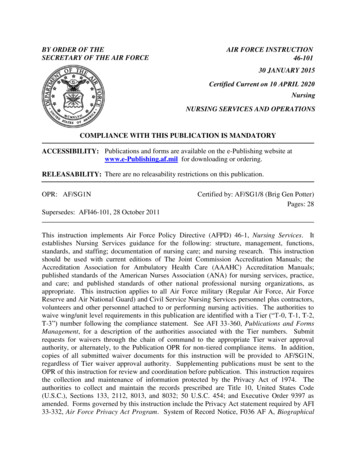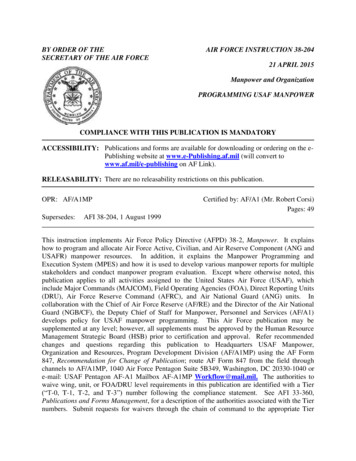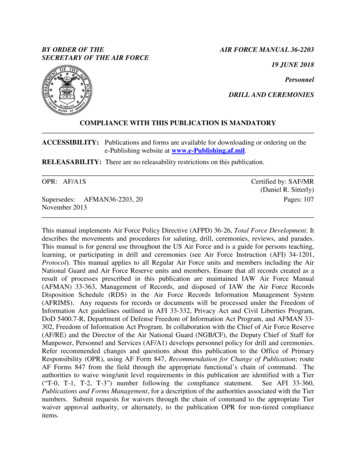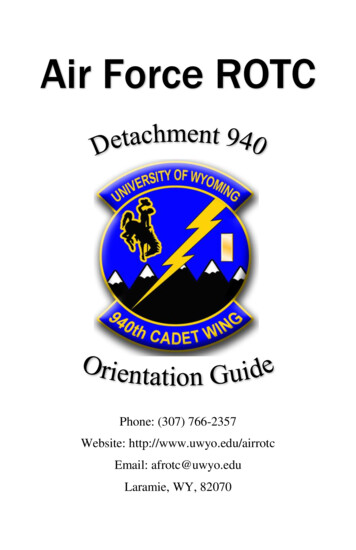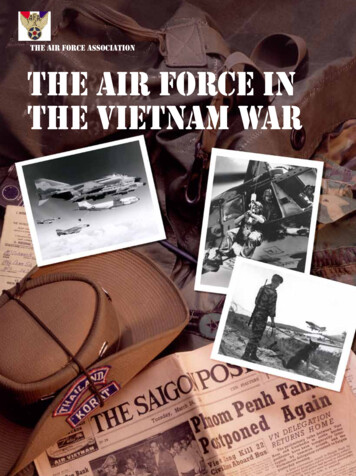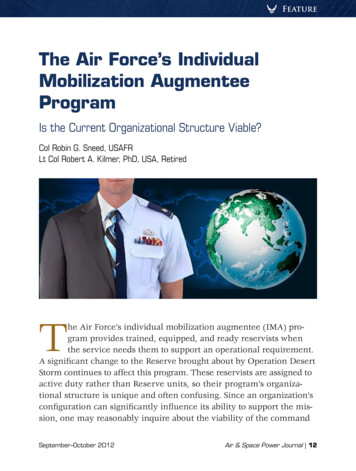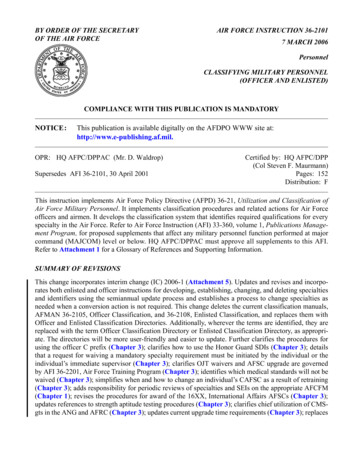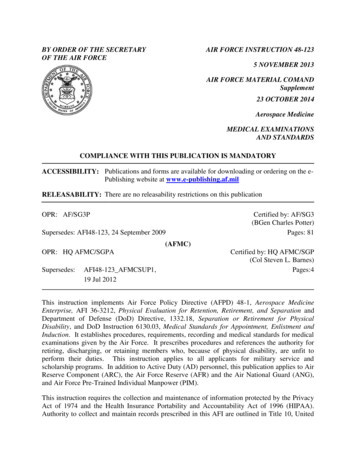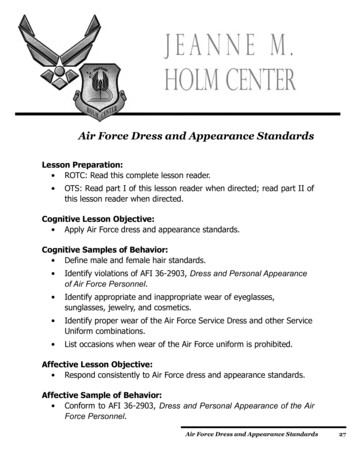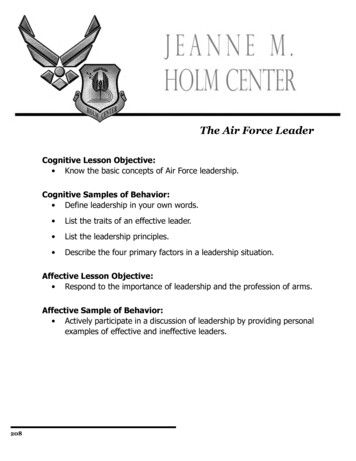
Transcription
The Air Force LeaderCognitive Lesson Objective: Know the basic concepts of Air Force leadership.Cognitive Samples of Behavior: Define leadership in your own words. List the traits of an effective leader. List the leadership principles. Describe the four primary factors in a leadership situation.Affective Lesson Objective: Respond to the importance of leadership and the profession of arms.Affective Sample of Behavior: Actively participate in a discussion of leadership by providing personalexamples of effective and ineffective leaders.208
THE AIR FORCE LEADERSHIP CONCEPTLeadership is the art and science of motivating, influencing and directing Airmen tounderstand and accomplish the Air Force mission. The concept of effective leadershipincludes two fundamental elements: the mission and the Airmen. They are embedded inthe definition of leadership.The Mission. The military organization’s primary task is to perform its mission. This isparamount, and everything must be subordinate to this objective. Thus, the leader’sprimary responsibility is to lead people to carry out the unit’s mission successfully. FormerAir Force Chief of Staff, General Curtis E. LeMay stated, “No matter how well you applythe art of leadership, no matter how strong your unit, or how high the morale of your men,if your leadership is not directed completely toward the mission, your leadership hasfailed.” Yet, a leader must never forget the importance of the unit’s personnel.The Airmen. Airmen perform the mission. They are the heart of the organization andwithout their support a unit will fail. One of a leader’s responsibilities is the care andsupport of the unit’s personnel. Successful leaders continually ensure the needs of theirsubordinates are met promptly and properly.Leadership TraitsEffective leaders have certain distinguishing characteristics, which are the foundationfor their approach to the leadership situation. The list of a leader’s desirable qualities isvirtually endless. While many characteristics (such as truthfulness) are expected of allmembers of the military profession, there are six traits that are vital to Air Force leaders.Integrity. The total commitment to the highest personal and professional standards. Aleader must be honest and fair. Integrity means establishing a set of values and adheringto those values. Former Air Force Chief of Staff General Charles Gabriel said, “Integrity isthe fundamental premise of military service in a free society. Without integrity, the moralpillars of our military strength--public trust and self-respect--are lost.”Loyalty. A three dimensional trait which includes faithfulness to superiors, peers, andsubordinates. Leaders must first display an unquestionable sense of loyalty before theycan expect members of their unit to be loyal. General George S. Patton Jr. highlighted theimportance of loyalty saying, “There is a great deal of talk about loyalty from the bottomto the top. Loyalty from the top down is even more necessary and much less prevalent.”Commitment. The complete devotion to duty. A leader must demonstrate total dedicationto the United States, the Air Force, and the unit. Plato said, “Man was not born for himselfalone, but for his country.” Dedicated service is the hallmark of the military leader.The Air Force Leader 209
Energy. An enthusiasm and drive to take the initiative. Throughout history successfulleaders have demonstrated the importance of mental and physical energy. Theyapproached assigned tasks aggressively. Their preparation included physical and mentalconditioning which enabled them to look and act the part. Once a course of action wasdetermined, they had the perseverance and stamina to stay on course until the job wascompleted.Decisiveness. A willingness to act. A leader must have the self-confidence to maketimely decisions. The leader must then effectively communicate the decision to the unit.British Admiral Sir Roger Keyes emphasized that, “In all operations a moment arriveswhen brave decisions have to be made if an enterprise is to be carried through.” Ofcourse, decisiveness includes the willingness to accept responsibility. Leaders are alwaysaccountable--when things go right and when things go wrong.Selflessness. Sacrificing personal requirements for a greater cause. Leaders mustthink of performing the mission and caring for the welfare of the men and women in theorganization. Air Force leaders cannot place their own comfort or convenience before themission or the people. Willingness to sacrifice is intrinsic to military service. Selflessnessalso includes the courage to face and overcome difficulties. While courage is often thoughtof as an unselfish willingness to confront physical dangers, equally important--and morelikely to be tested on a daily basis--is the moral courage a leader needs to make difficultdecisions. General Douglas MacArthur said, “No action can safely trust its martial honorto leaders who do not maintain the universal code which distinguishes those things thatare right and those things that are wrong.” It requires courage and strength of character toconfront a tough situation head-on rather than avoiding it by passing the buck to someoneelse.These traits are essential to effective leadership. Developing them in yourself will improveyour ability to employ the leadership principles.Leadership PrinciplesAn Air Force officer is flexible enough to meet changing circumstances, competentenough to perform under adverse conditions, courageous enough to lead at the risk of lifeor career, and courageous enough to stand on principle to do what is right. The leadershipprinciples are guides that have been tested and proven over time by successful leaders.Many of these principles are related to the Air Force Core Values. As you comprehendand apply these principles, you and your subordinates will begin to experience successin all your efforts.Take Care of Your People. People are our most valuable resource and should becared for to the best of a leader’s ability. The time and effort a leader spends takingcare of subordinates and co-workers will be amply rewarded in increased unit morale,effectiveness, and cohesion. Leaders should exhort each unit member to reach theirhighest potential and thus maximize their value to the Air Force. An effective and thorougheffort to resolve threats to the individual’s and family’s well being will free Airmen to210
achieve their potential. Find out what their requirements are and be sensitive to theirneeds. Are the people housed adequately; are they well fed; are they paid promptly; arethere personal problems with which they need help? When people are worried aboutthese conditions, they cannot focus their full attention on their job, and the mission willsuffer. If people believe they are cared for as well as circumstances will permit, the leaderis in a position to earn their confidence, respect, and loyalty.Motivate People. Your greatest challenge is motivating subordinates to achieve the highstandards set for them. Motivation is the key to successful leadership. Motivation is themoving force behind successful leadership. In fact, the ability to generate enthusiasmabout the mission may be the single most important factor in leadership. Recognitionof the efforts people put forth is one positive way in which motivation toward missionaccomplishment pays dividends. The leader who publicly applauds the efforts of unitpersonnel builds a cohesive organization, which will accomplish the mission.Motivating people depends on understanding their needs and working to align theseneeds with unit requirements. Most people will work for an organization, which they know,cares about them, and one in whose mission they believe. Remember, the most powerfulform of lasting motivation is self-motivation. One of your goals as a leader should be toprovide an environment that fosters and rewards self-motivation.Be a Follower. The Air Force expects all its leaders first to be followers. Airmenobserve their leaders and take from them successful traits while avoiding those thatare counterproductive. Good followers also understand and take personal pride in theircontribution to the total Air Force mission; they have the strength of character to begratified by the collective pride in a fine team effort without seeking individual reward.Effective followers have the strength of character to flourish without seeking “hero” statusand are willing and able to participate in a team effort to effectively employ air and spacepower.Know Your Job. People will follow a competent person who has the knowledge neededto complete the mission successfully. The Air Force leader should have a broad view ofthe unit’s mission, and should ensure all members understand how their jobs relate tomission accomplishment.Between World War I and World War II, the Army Air Corps was fortunate to have men likeGeneral Henry “Hap” Arnold and General Carl Spaatz. These men knew their jobs and howthey could enhance the mission. Their preparation and vision paid substantial dividendswhen they were charged with building a force to fight the air battles of World War II. But,just as important as their own competence, these leaders ensured assigned people knewtheir responsibilities. Former Chairman of the Joint Chiefs of Staff General Maxwell Taylorstated, “One expects a military leader to demonstrate in his daily performance a thoroughknowledge of his own job and further an ability to train his subordinates in their duties andthereafter to supervise and evaluate their work.”The Air Force Leader 211
Know Yourself. Knowing your own strengths and weaknesses is important to successfulleadership. You, the leader, must recognize your personal capabilities and limitations.Former Chief Master Sergeant of the Air Force Robert D. Gaylor put it this way: “Sure,everyone wants to be an effective leader, whether it be in the Air Force or in the community.You can and will be if you identify your strengths, capitalize on them, and consciously striveto reduce and minimize the times you apply your style inappropriately.” Don’t, however,ignore your weaknesses. Recognize them and strive to overcome them. In the interim,select team members whose strengths compensate for your weaknesses so that yourcollective efforts will get the job done.Set the Example. You must set the standard for the unit. People will emulate your standardsof personal conduct and appearance. They will observe your negative characteristics aswell as your positive ones. A leader’s actions must be beyond reproach, if he or she isto be trusted. Deviations from high standards will only be amplified and the message ofa leader’s actions will permeate the entire organization. Regardless of how strongly wefeel about ourselves, it is the public perception of our actions that count in the end. Forexample, the supervisor who violates basic standards of morality invariably ends up ina comprising situation. A leader who drinks excessively or who abuses controlled drugssends a dangerous message: I cannot control myself; how can I control you? Lack ofself-discipline in a leader destroys the unit’s cohesion and, ultimately impairs its ability toperform the mission.People do not expect their leaders to be saints. But they do expect leadership from aperson who recognizes the importance of example. As General George S. Patton, Jr.once remarked, “You are always on parade.”Communicate. Information should flow continuously throughout the organization. FormerAir Force Chief of Staff General Thomas D. White believed, “Information is the essentiallink between wise leadership and purposeful action.” Communication is a two-wayprocess. An informed leader is able to evaluate realistically the unit’s progress towardmission accomplishment. Successful leaders listen to what their people have to say, andare always looking for the good ideas which can flow up the chain. It is the leader’s job tokeep all channels open. The more senior a leader becomes, the more listening skills arerequired.Educate Yourself and Others. People should be properly trained to do their jobs.Education, technical training schools, and on-the-job training are formal means by whichAir Force personnel are trained. Informal training, practice, and personal experience atthe unit level are crucial reinforcements to formal training. General of the Army DouglasMacArthur observed, “In no other profession are the penalties for employing untrainedpersonnel so appalling or so irrevocable as in the military.” Greater efficiencies arepossible with a highly trained and skilled force; therefore, education must be a top priority.Equip Your Troops. It’s your responsibility to ensure the unit is equipped properly toaccomplish the mission. If they do not have the proper tools, obtain them. Proper toolsinclude equipment and facilities that lead to mission accomplishment. Occasionally,needed tools are not available in enough quantity or are not available to you at all, despite212
your best efforts to obtain them. In these situations a good leader works to develop acreative alternative and solicits solutions from those doing the job. A poorly equippedforce cannot capitalize on its extensive training and requires more personnel or time toaccomplish its mission than a properly equipped force. Your leadership responsibilitiesinclude identifying needs, securing funds, and then obtaining the necessary weapons,tools, and equipment.Accept Responsibilities. General Curtis E. LeMay was once asked to provide a oneword definition of leadership. After some thought, General LeMay replied, “If I had tocome up with one word to define leadership, I would say responsibility.” As a leader youare responsible for performing the unit’s mission. If you fail, you are accountable forthe consequences. Any unwillingness to accept responsibility for failure destroys yourcredibility as a leader and breaks the bond of respect and loyalty. Accountability alsoincludes the requirement for discipline within a unit. A leader should reward a job welldone and punish those who fail to meet their responsibilities or establish standards. Theformer is easy, even enjoyable; the latter is much more difficult, but equally necessary.George Washington observed, “Discipline is the soul of an Army. It makes small numbersformidable; procures success to the weak, and esteem to all.”Develop Teamwork. Leaders cannot accomplish the mission alone. It is also impossiblefor followers to accomplish the entire mission while working completely alone. As a leaderyou must mold a collection of individual performers into a cohesive team that workstogether to accomplish the mission. The unit’s mission will suffer if each person in yourorganization is “doing his own thing” in isolation. As the leader, you should know howthe various functions within the unit fit together and how they must work in harmony. Youshould create and maintain an atmosphere of teamwork and cooperation to meet missiondemands. Teamwork comes when people are willing to put the unit’s mission before allelse.THE LEADERSHIP SITUATIONLeadership has been defined as the art of influencing and directing people to accomplishthe mission. Management is the manner in which resources are used to achieve objectives.Military leaders should also be aware of their responsibilities as Air Force managers.British Field Marshall Lord Slim made a clear distinction:There is a difference between leadership and management. The leaderand the men who follow him represent one of the oldest, most natural,and most effective of all human relationships. The manager and those hemanages are a later product with neither so romantic, nor so inspiring ahistory. Leadership is of the spirit, compounded of personality and vision-its practice is an art. Management is of the mind, more a matter of accuratecalculation, statistics, methods, timetables, and routine--its practice is ascience. Managers are necessary; leaders are essential.The Air Force Leader 213
In essence, you lead people and you manage things. The Air Force needs people whocan do both. The requirement is for the proper division of attention between the two, withthe proportion dependent on the situation. Approach each leadership situation payingcareful attention to the four primary factors: the mission, the people, the leader, and theenvironment.The Mission. Most missions involve many tasks that must be completed if the unit isto fulfill its responsibilities. The leader must define the mission and set priorities for itsvarious components. In many instances higher headquarters has defined the mission.Yet, the leader should translate the higher direction into goals with which people willrelate. When possible, the leader should involve unit personnel in setting these goals toensure their support. Individual involvement is very important when total effort is neededfrom everyone. The goals must be challenging but attainable. Goals that are unrealisticfrustrate even the most dedicated people.Set reasonable and acceptable standards of job performance to make sure that goals aremet. These standards must be consistent with the mission, and defined clearly for everyindividual. Recognize those who meet or exceed standards, prescribe additional trainingfor those who cannot, and take corrective action for those who will not. When standardsare not met, determine the reason and move quickly to correct the situation throughtraining or, if appropriate, administrative or disciplinary action. Get the facts, then act.The People. Be sensitive to people. People perform the mission. Understanding peoplehelps determine the appropriate leadership action to take in a given situation. You cannotbe totally successful at getting the most out of people without first knowing the capabilitiesof those you are leading. Capabilities have two principal elements: training and experience. Training. Assess the level of training in the unit. If the people are not trained,do what it takes to get them the necessary training. Your subordinates cannotsuccessfully accomplish the mission without the proper training. Medal of Honorrecipient Sergeant John L. Levitow credited his heroic action under fire to thetraining he received. Experience. Levels of experience vary widely. A leader should identify eachindividual’s experience and ability to perform in various situations. Do not baseyour evaluation of an individual’s experience solely on rank. While rank may bea good overall experience indicator, the person may never have accomplished aparticular job or been in a particular environment.The Leader. Successful military leaders adapt their leadership style to meet the missiondemands, and use an approach that capitalizes on their strengths. For example, if you areable to communicate effectively with people on an individual basis but are uncomfortablewhen speaking to large groups, then use personal conferences as much as possible.If you write well, take advantage of this skill by writing letters of appreciation or usingother forms of correspondence. If you are a good athlete, organize and participate inunit sporting activities. In other words, capitalize on your strengths and minimize yourweaknesses.214
The Environment. Leaders should carefully consider the environment in which they work.Leadership methods, which worked in one situation with one group, may not work withthe same group in a different environment. Consider the squadron that is permanentlybased in the United States, but deploys overseas for an extended period of temporaryduty. Billeting or food service difficulties, equipment, or parts shortages, family separationproblems, inclement weather, etc. may occur. Any of these problems create an entirelynew environment with which the unit’s leader must cope. As a leader, you must alter yourleadership behavior, as necessary, to accommodate changes in the environment of thegiven mission. Be sensitive to your surroundings.ROLES OF LEADERSHIP AND MANAGEMENTTo better explain the roles of management and leadership, we’ll examine them in terms ofthree elements: behavior, personal characteristics, and organizational situation.Behavior. Managerial behavior is based on building organizational relations that meshtogether like parts of a timepiece. Leadership behavior, on the other hand, concentrates onmaking the hands of the timepiece move so as to display the time of day. The behavioralfocus of each is clearly important, but while the manager may be preoccupied with theprecision of the process, the leader concentrates on the inertial forces that drive theprocess. Warren Bennis, a professor and researcher who has devoted years to studyingleadership, summarizes the two behaviors as: “Management is getting people to do whatneeds to be done. Leadership is getting people to want to do what needs to be done.”Effective leaders are often described as “dynamic,” which is regarded as beneficialbecause it denotes movement and change. The function of leadership is not only toproduce change, but also to set the direction of that change. Management, however, usesthe function of planning to produce orderly results, not change.MANAGERSLEADERS Administers Motivates Maintains Develops Controls InspiresManagers use the management process to control people by pushing them in the rightdirection. Leaders motivate and inspire people by satisfying their human needs, keepingthem moving in the right direction to achieve a vision. To do this, leaders tailor theirbehavior towards their followers’ need for achievement, sense of belonging, recognition,self-esteem, and control over their lives. Bennis offers the following summary of thisbehavioral comparison:The Air Force Leader 215
Personal Characteristics. The following figure illustrates an interesting comparisonof successful leaders and managers that was researched by Professor Robert Whiteof Indiana University. Everyone who has been exposed to both types of characteristicsknows from experience that neither is exclusively positive or negative.MANAGERSLEADERS Problem solvers Analysts of purpose and causes Statistics driven Values driven Seek conflict avoidance Not only accept, but invite conflict Thrive on predictability Ambiguous Assure that the organization’sobjectives are achieved, even ifthey disagree with them Assure that their objectives andthose of the organization becomeone and the sameThe best managers tend to become good leaders because they develop leadership abilitiesand skills through practicing good management techniques. Seldom is there an effectiveleader who has not been a good manager. Similarly, managers who become successfulleaders have humanized their management skills with inspiration, empowerment, andvision through a catalyst called charisma. Social scientist Alan Bryman goes so far as tosuggest that management styles may set the stage for charisma.Organizational Situation. What are the organization implications of these two conceptsof management and leadership? Leaders launch and steer the organization towardsthe pursuit of goals and strategies. Managers ensure the resources needed to get thereare available and are used along the way. An organization needs both leadership andmanagement, and if they are combined in one person or persons, so much the better.To achieve a plan, managers organize and staff jobs with qualified individuals,communicating the plan to those people, delegating the responsibility for carrying out theplan, and devising systems to monitor its implementation. What you, as an officer, willneed to do, however, is not to organize people, but to align them, and that is a leadershipactivity.ConclusionWhat is the relative importance of effective leadership and management? Strong leadershipwith weak management is no better, and sometimes actually worse, than the opposite.The challenge is to achieve a balance of strong leadership and strong management. Apeacetime military can survive with good administration and management up and down216
the hierarchy, coupled with good leadership concentrated at the top. A wartime force,however, needs competent leadership at all levels. Good management brings a degree oforder and consistency to key issues like readiness, availability, and sustainment. But noone has yet figured out how to manage people into battle. They must lead.Embrace these proven leadership traits and principles. The Air Force requires everyAirman, officer and enlisted, to reflect these traits and principles, at every level, whenperforming the Air Force mission--our success in war and peace depends on it.BATTLE LEADERSHIP EXAMPLESFROM THE FIELDMajor General William A. Cohen, U.S. Air Force Reserve, RetiredMore than 40 years ago, management guru Peter F. Drucker reiterated that the firstsystematic book on leadership, written 2,000 years ago by Xenophon, a Greek general, isstill the best on the subject.1 Xenophon’s book on combat leadership describes leadershipactions during a five-month campaign when he and others, although surrounded by ahostile and numerically superior foe, led 10,000 men in a retreat from Babylon to theBlack Sea. If the concepts of battle leadership written 2,000 years ago are so powerfulthey attract the recommendation of probably the greatest management thinker of ourtime, I thought they might well apply to nonbattle environments also.The fact is, a professional Soldier, Sailor, Marine or Airman spends most of his or hercareer preparing for war or cleaning up after a war--not fighting. Moreover, modernwarfare requires a supporting cast far larger than just those who actually wield weapons.So, whether assuming combat responsibilities or serving in a noncombat function as a“war supporter,” combat leadership potentially seems to have something to offer outsidethe confines of the battlefield.Is Conventional Thought Wrong?That combat leaders have anything to offer noncombat leaders flies in the face ofconventional thinking. Even some military people feel that war is war and so unique as ahuman endeavor that nothing derived from it has any noncombat application. Yet, muchtechnology and cures for diseases have sprung from wartime developments. No less amilitary thinker than B.H. Liddell Hart, writing of his concept of the indirect approach inhis classic book Strategy, states: “With deepened reflection, however, I began to realizethat the indirect approach had a much wider application--that it was a law of life in allspheres.”2The Air Force Leader 217
Many military leaders who never served in battle probably apply combat leadershipprinciples without considering what they are doing or where their ideas and leadershipphilosophies originated. General Dwight D. Eisenhower commanded the largest seaborneinvasion in history. However, he had no actual combat leadership experience. GeneralHenry H. “Hap” Arnold was the only Airman to wear five stars, and he commanded thelargest air force in history, but he never served as a combat leader either.Some civilians believe that leadership in battle consists only of running around shoutingorders. If this were true, there would not be a lot we could learn from it to apply elsewhere.In my judgment, battle leadership represents probably the greatest leadership challengefor any leader. There are significant hazards. There are poor working conditions. Thereis probably greater uncertainty than in any other type of human activity. It may be theonly leader activity where both followers and leaders would rather be somewhere else.Further, as Drucker points out, “In no other type of leadership must the leader makedecisions based on less, or less reliable, information.”3While there are true military geniuses in battle, the majority of people in the military, asin most organizations, are ordinary men and women--not military professionals. And, notall are suited to their jobs. Whether a professional or a trained amateur, all soldiers arestressed far more than those in any civilian situation or occupation. Also, leaders must notonly carry out the mission, they must also be responsible for the lives of those they lead.So, battle represents a “worst-case” condition. No wonder traditional motivators such ashigher pay, good benefits and job security are not much good. There is no “business asusual” on the battlefield.Under these conditions, good leaders enable ordinary people to routinely accomplishthe extraordinary. In battle, leaders help their followers reach difficult goals and completearduous tasks. People in such an environment cannot be managed—they must beled. And under terrible conditions, successful combat leaders build and lead amazingorganizations that get things done ethically, honestly and, for the most part, humanely.Goldwater’s SuggestionBack in 1989, Senator Barry Goldwater endorsed an earlier book of mine on leadershipthat described the techniques of leadership as an art. Goldwater stated that while mytechniques were sound, all were founded on certain principles such as basic honesty.According to him, all leadership techniques must be derived from these basic principlesor they will not work.4Assuming Goldwater was correct, while leadership techniques depend on the situationand the leader’s as well as the followers’ styles, there are basic principles from whichall techniques are derived that are always true.5 Once these principles are uncovered,techniques in any situation almost automatically follow. Moreover, if general leadershipprinciples from the worst-case scenario could be documented, they would have anextremely important impact on many other activities. Leaders from all organizations coulduse these principles to dramatically increase productivity and the likelihood of success in218
any project in which they were engaged. Such principles could be likened to the law ofgravity. A stone dropped from an outstretched hand will fall whether the one who dropsit is a combat leader, a business leader, a
An informed leader is able to evaluate realistically the unit's progress toward mission accomplishment. Successful leaders listen to what their people have to say, and are always looking for the good ideas which can flow up the chain. It is the leader's job to keep all channels open. The more senior a leader becomes, the more listening .


